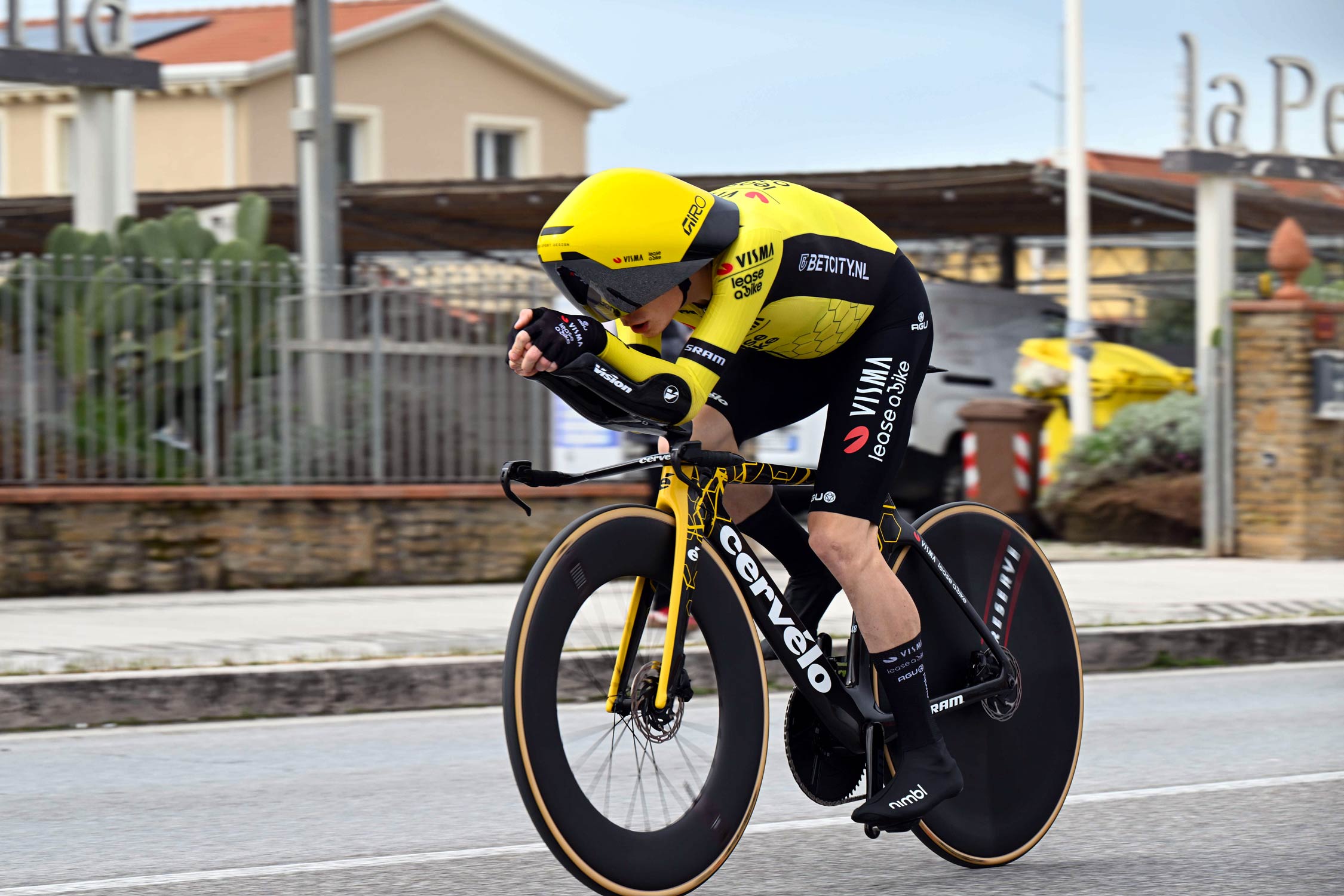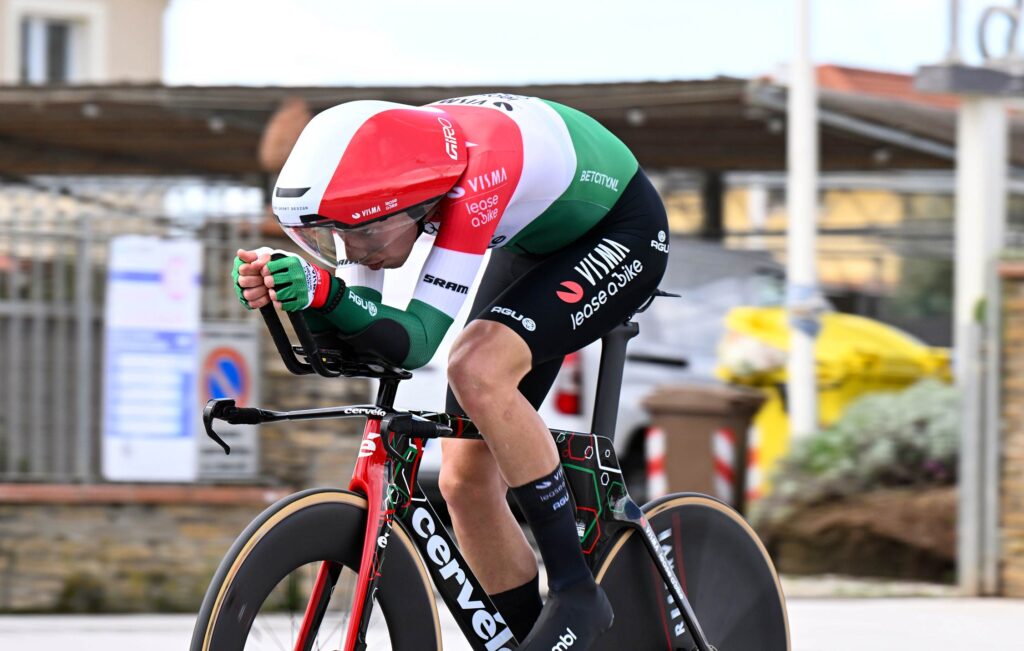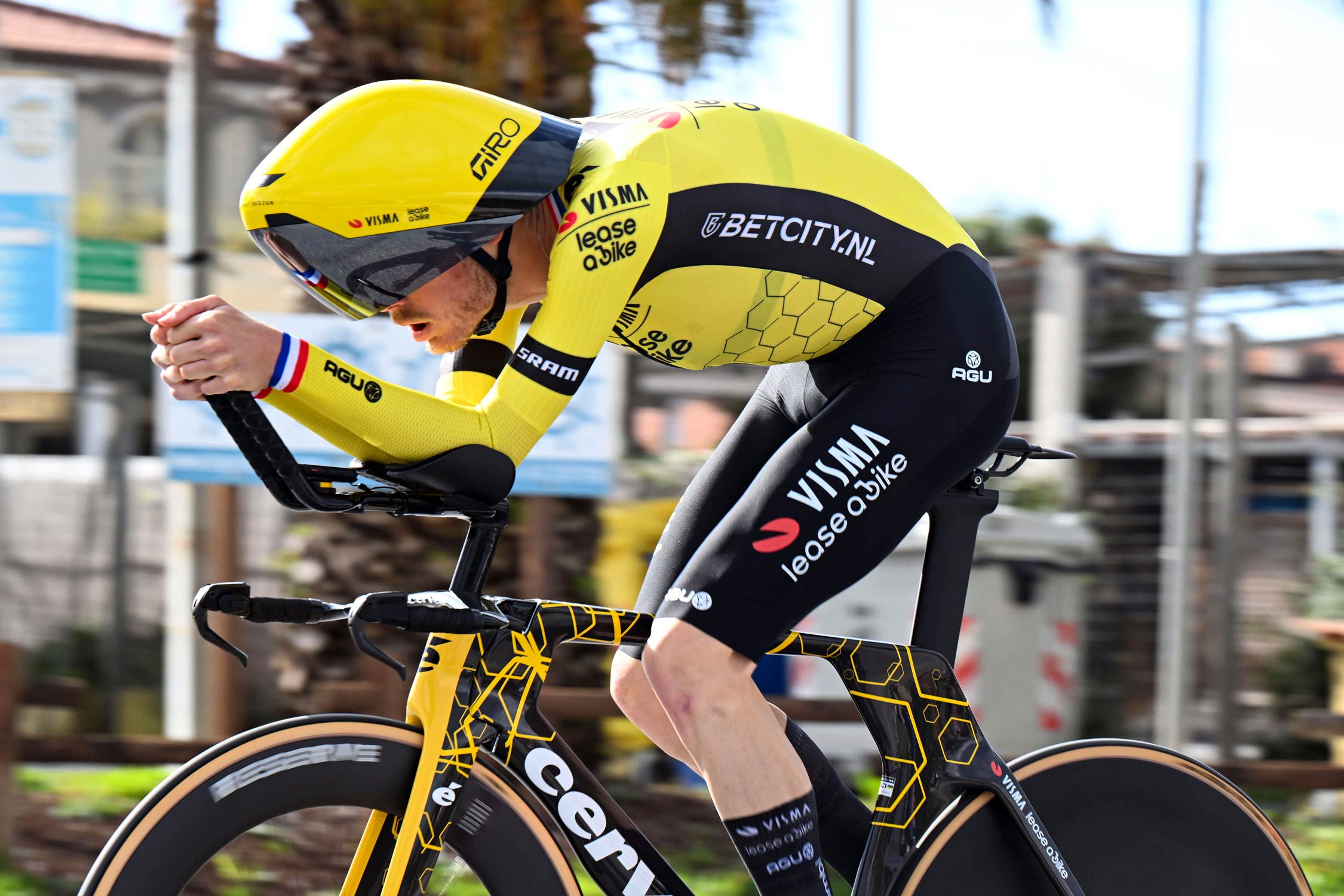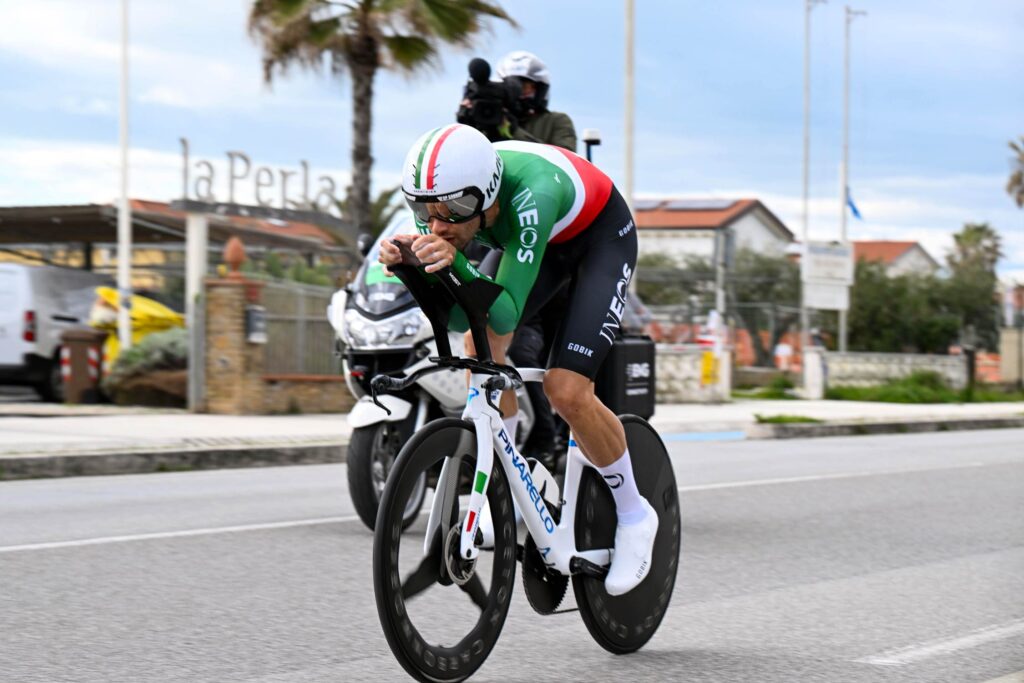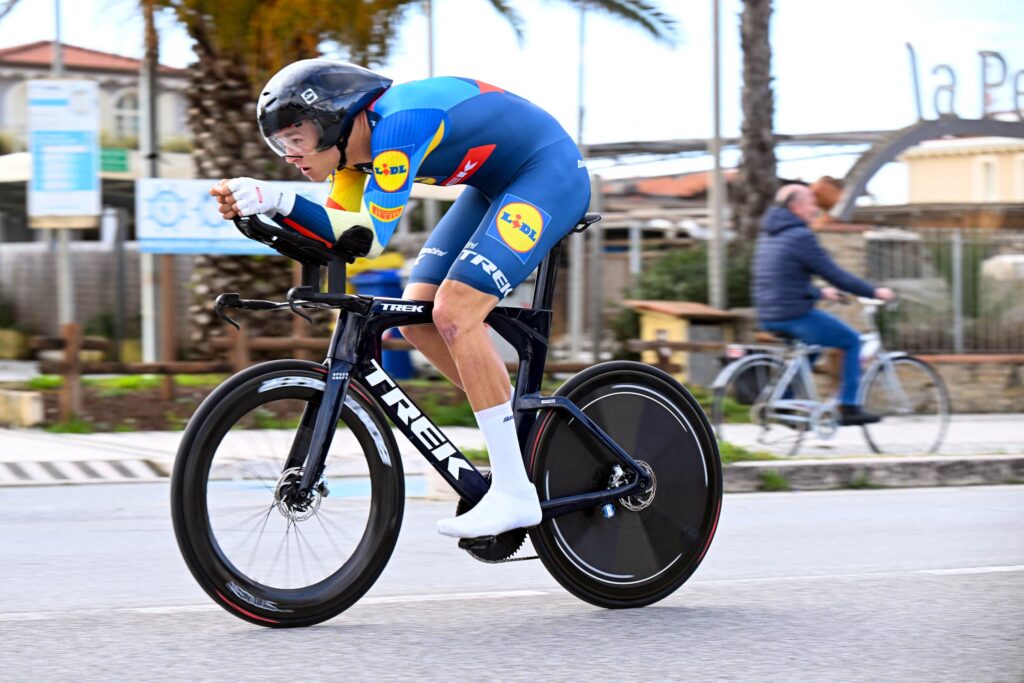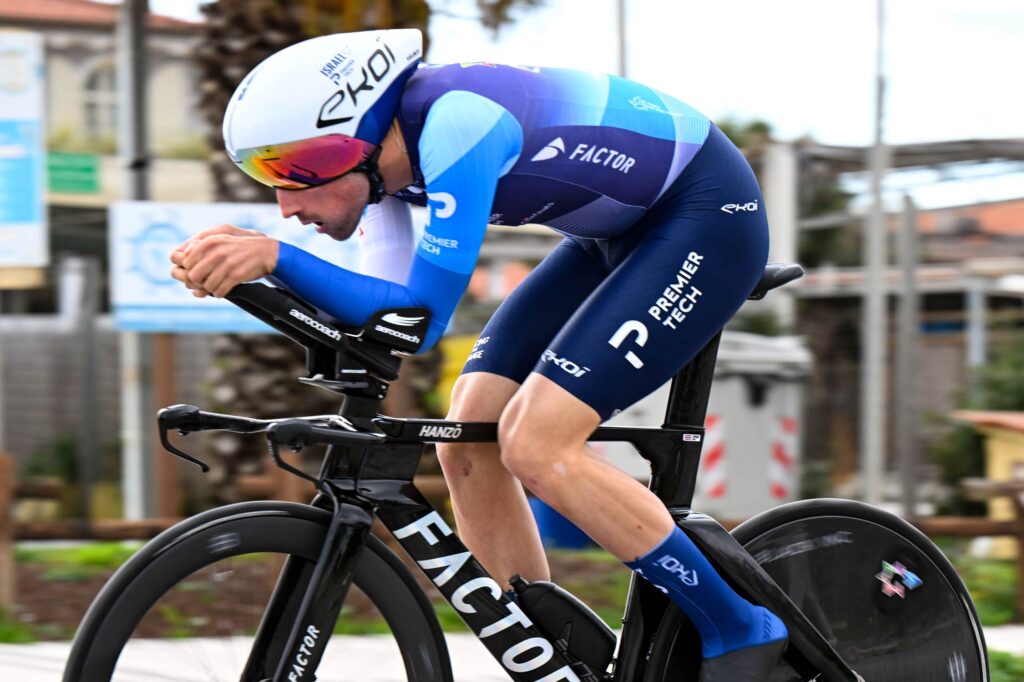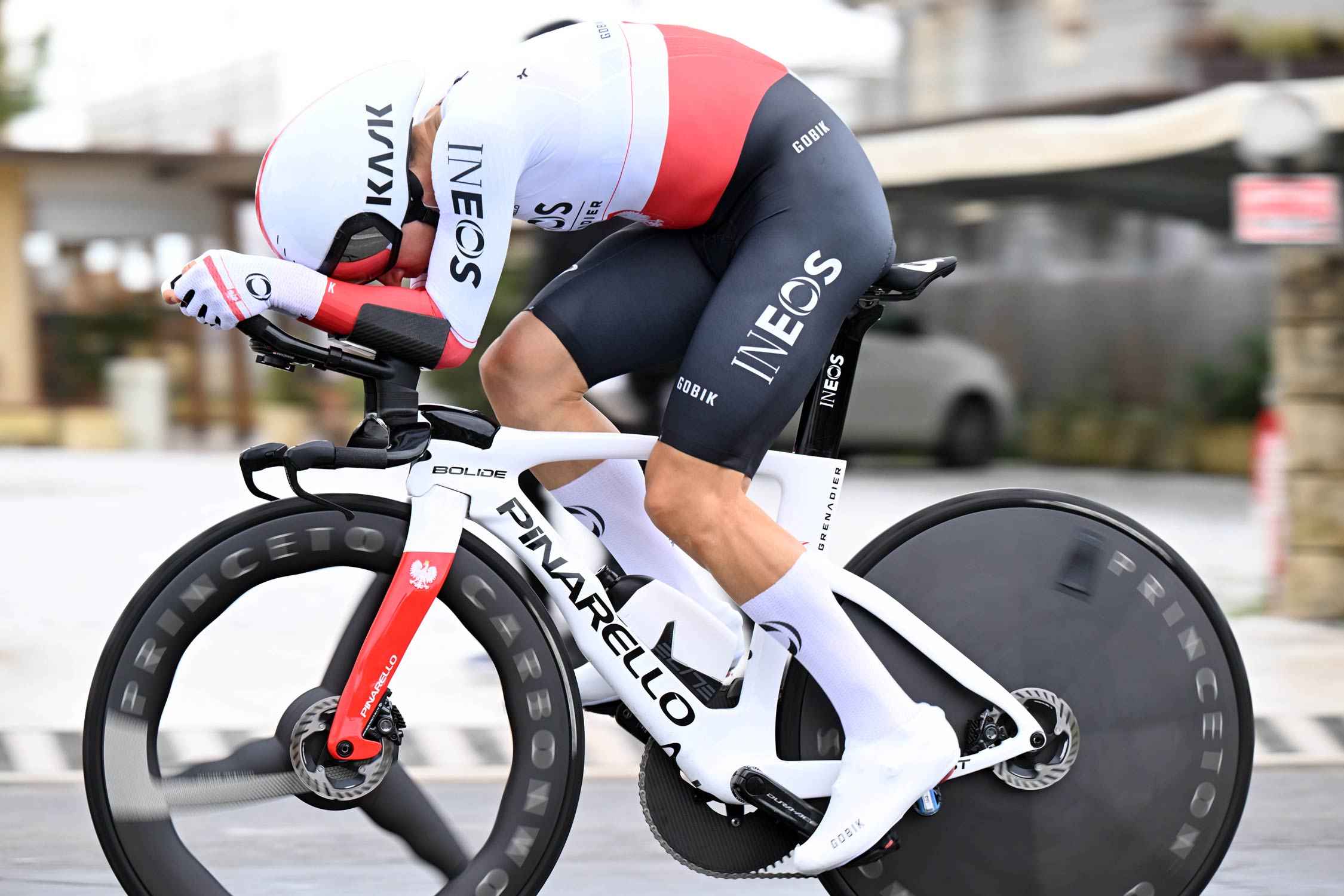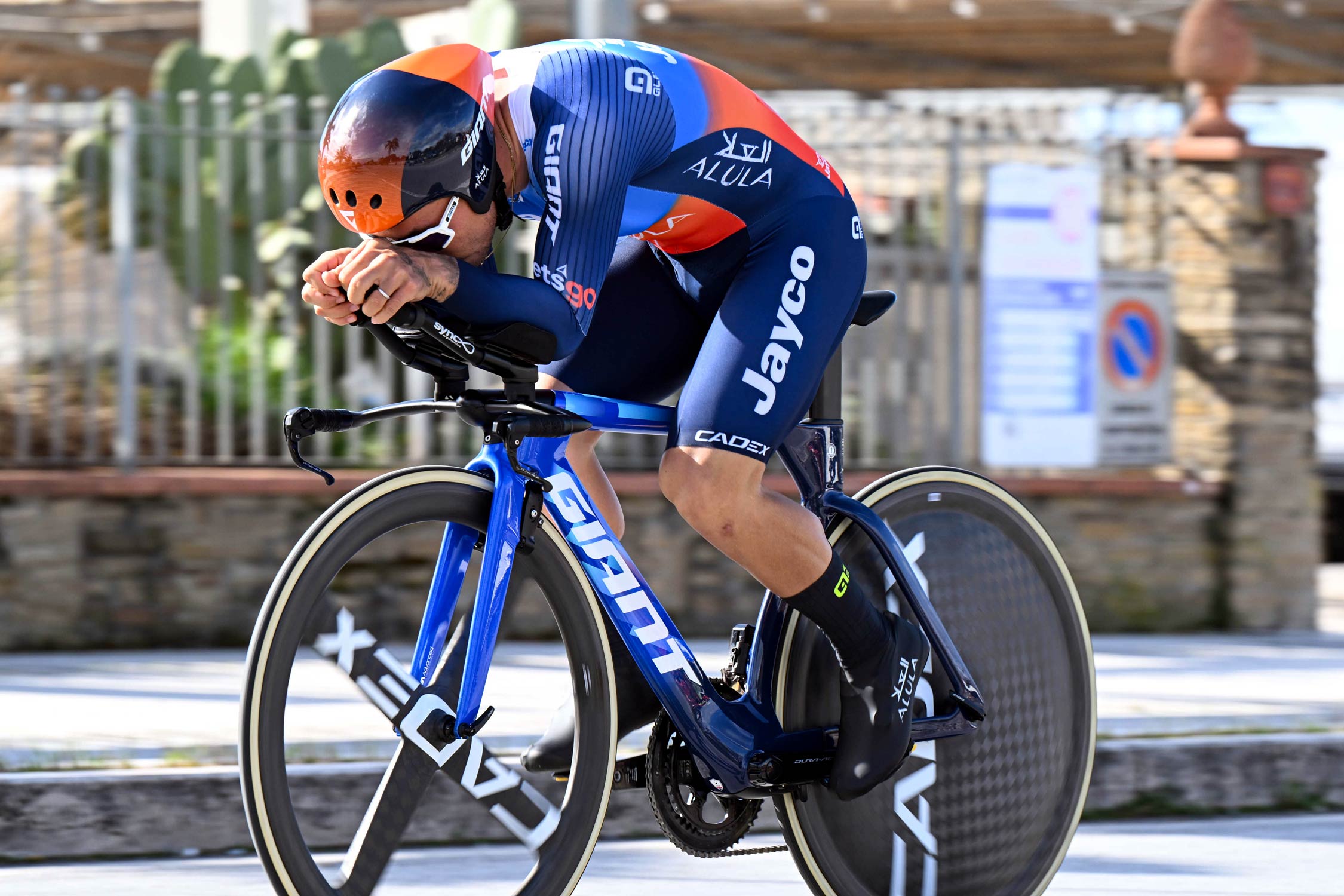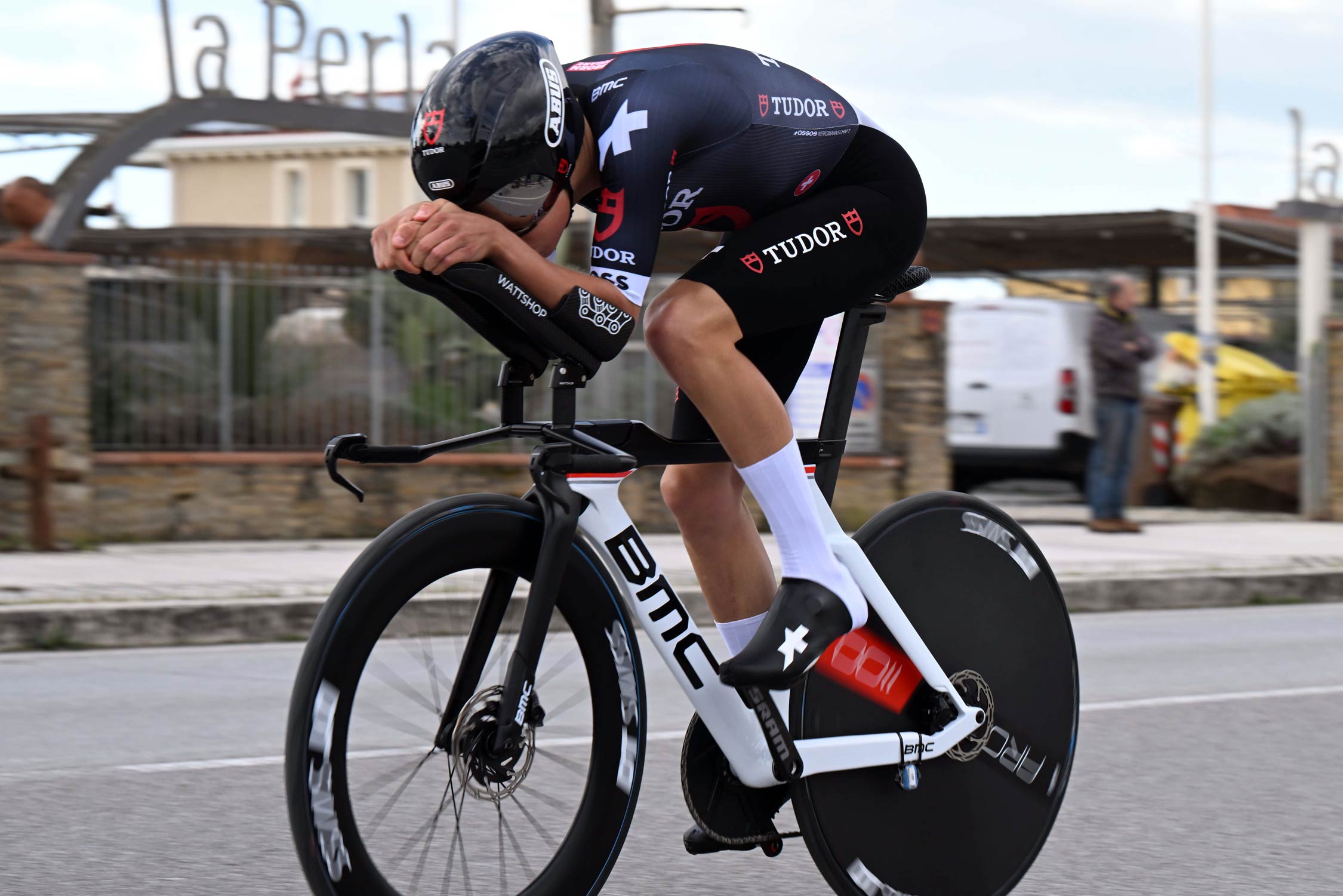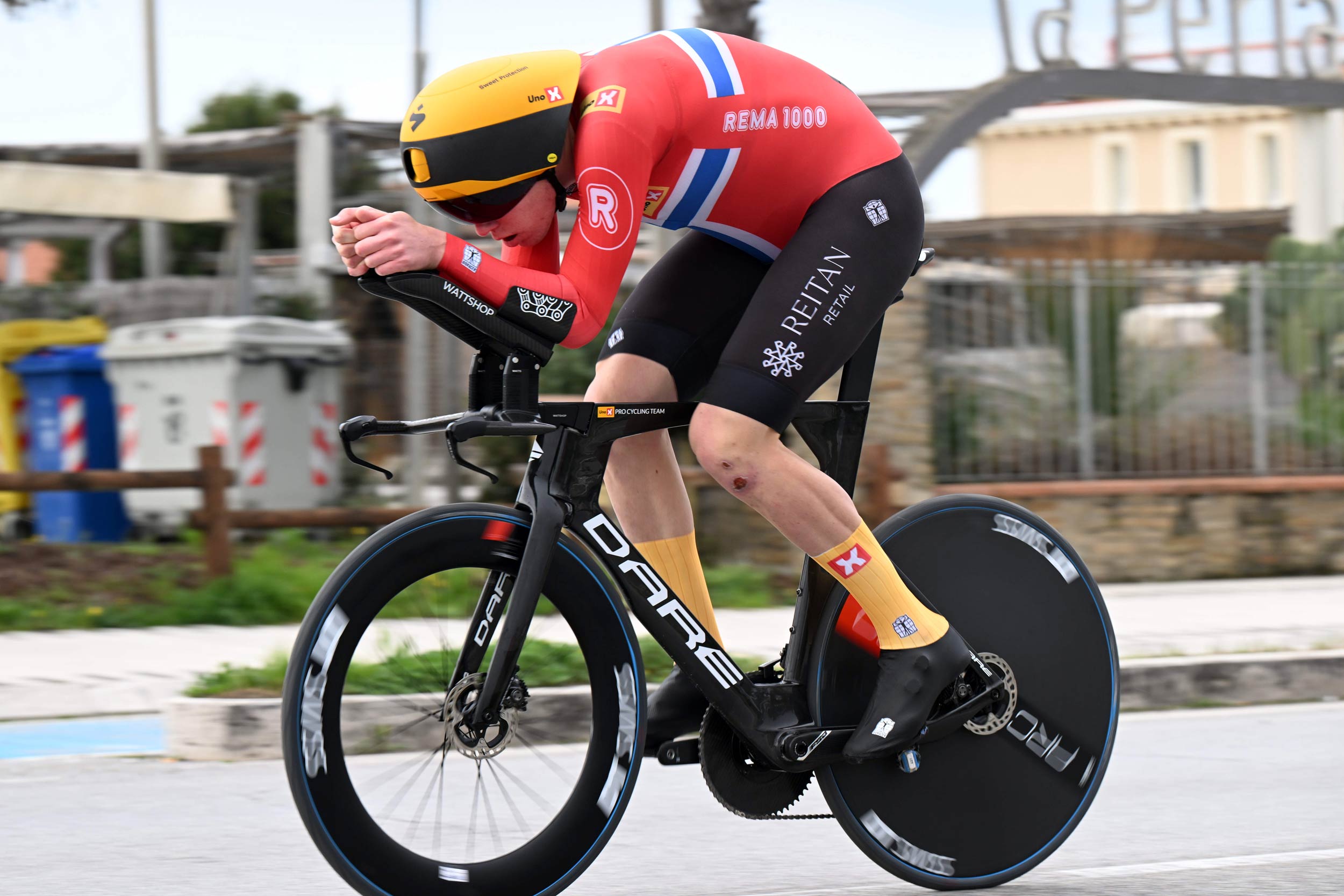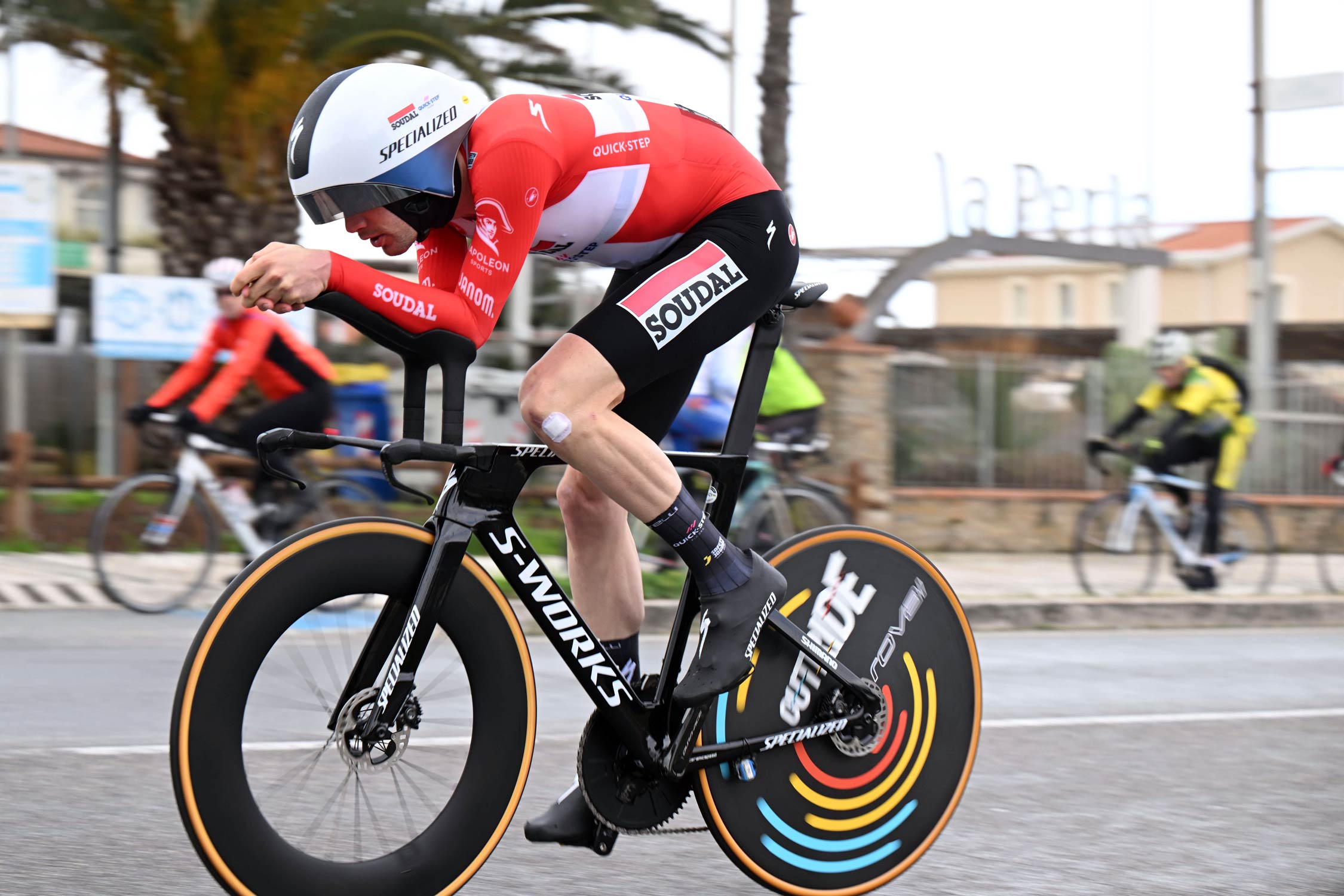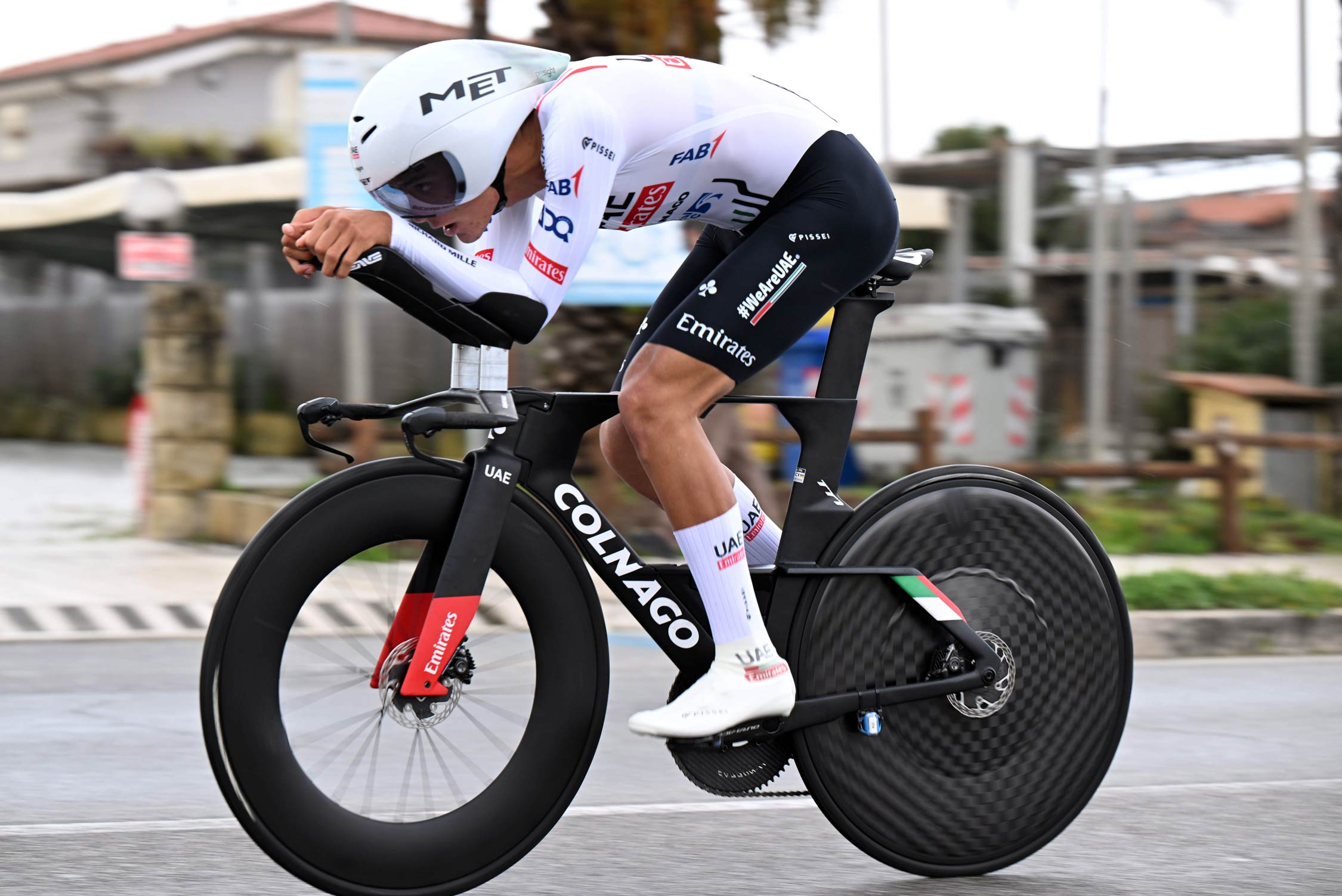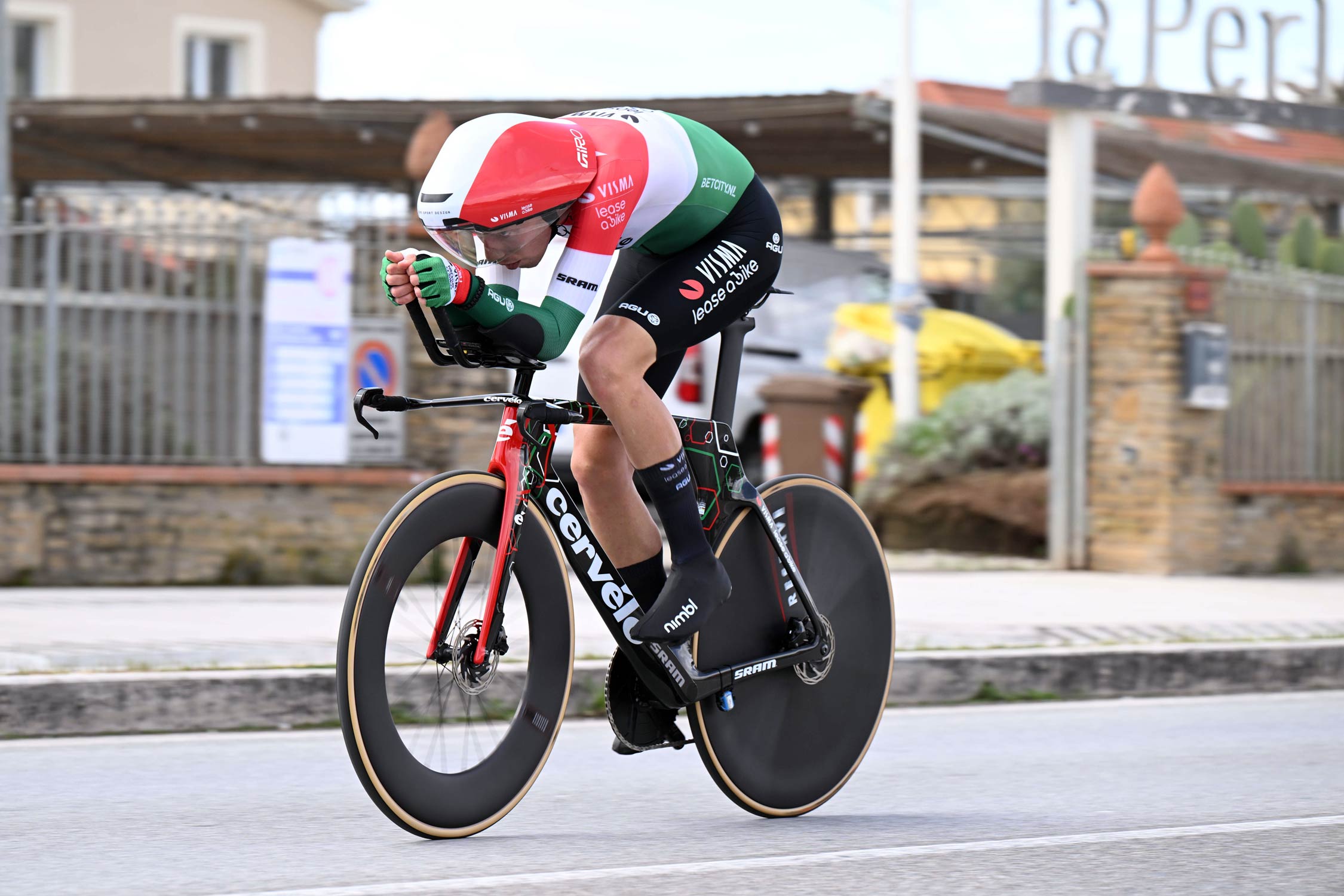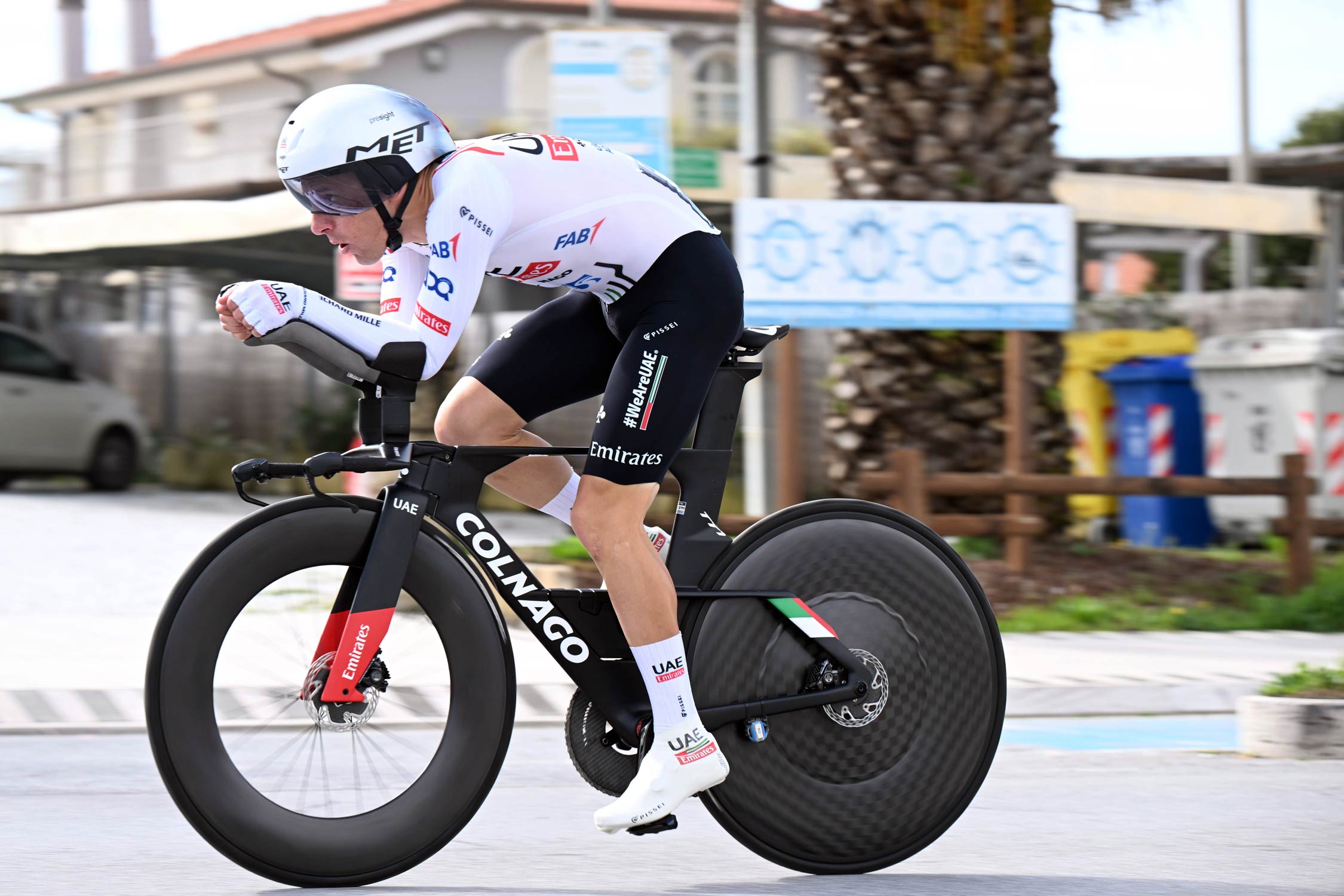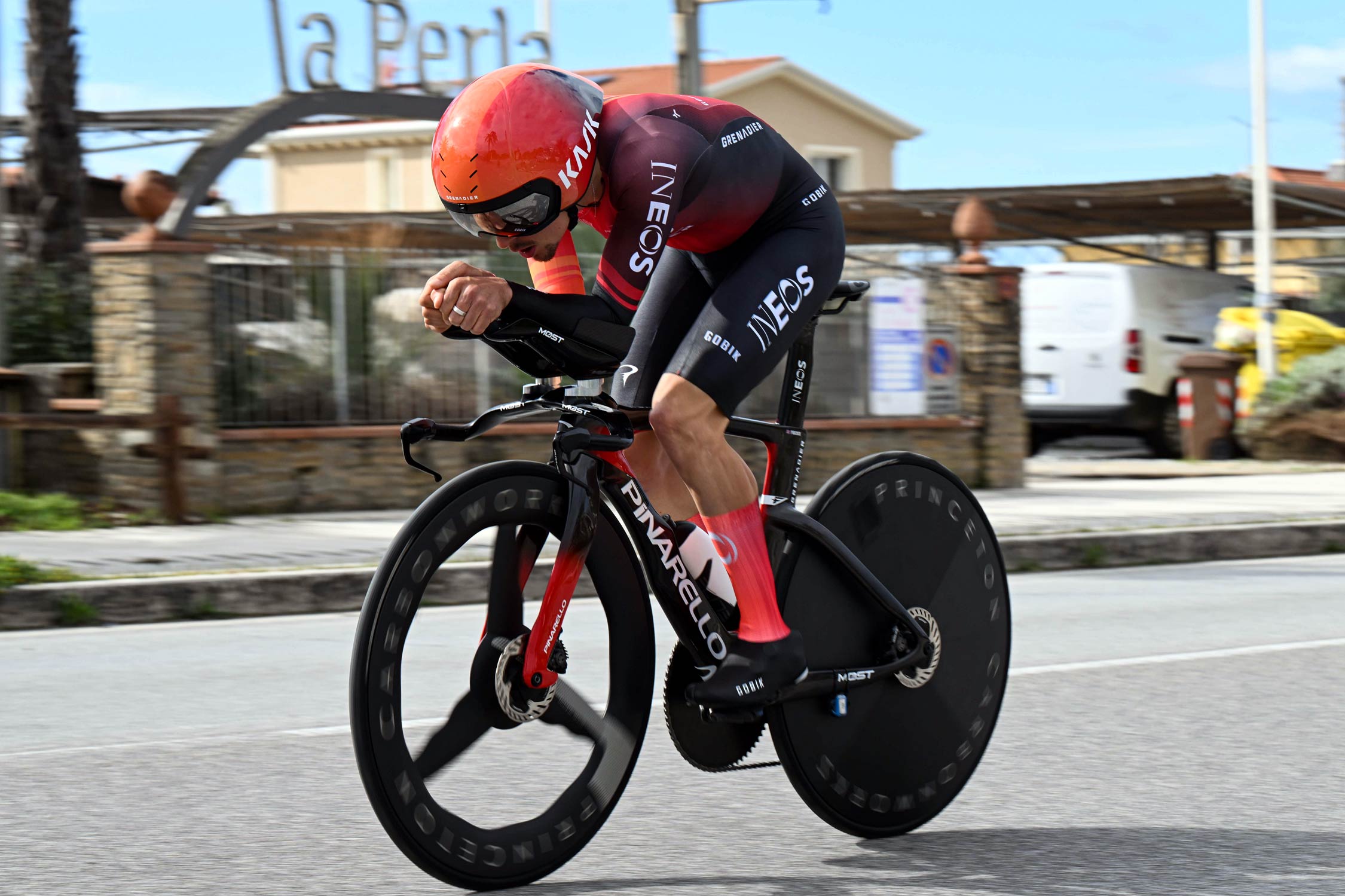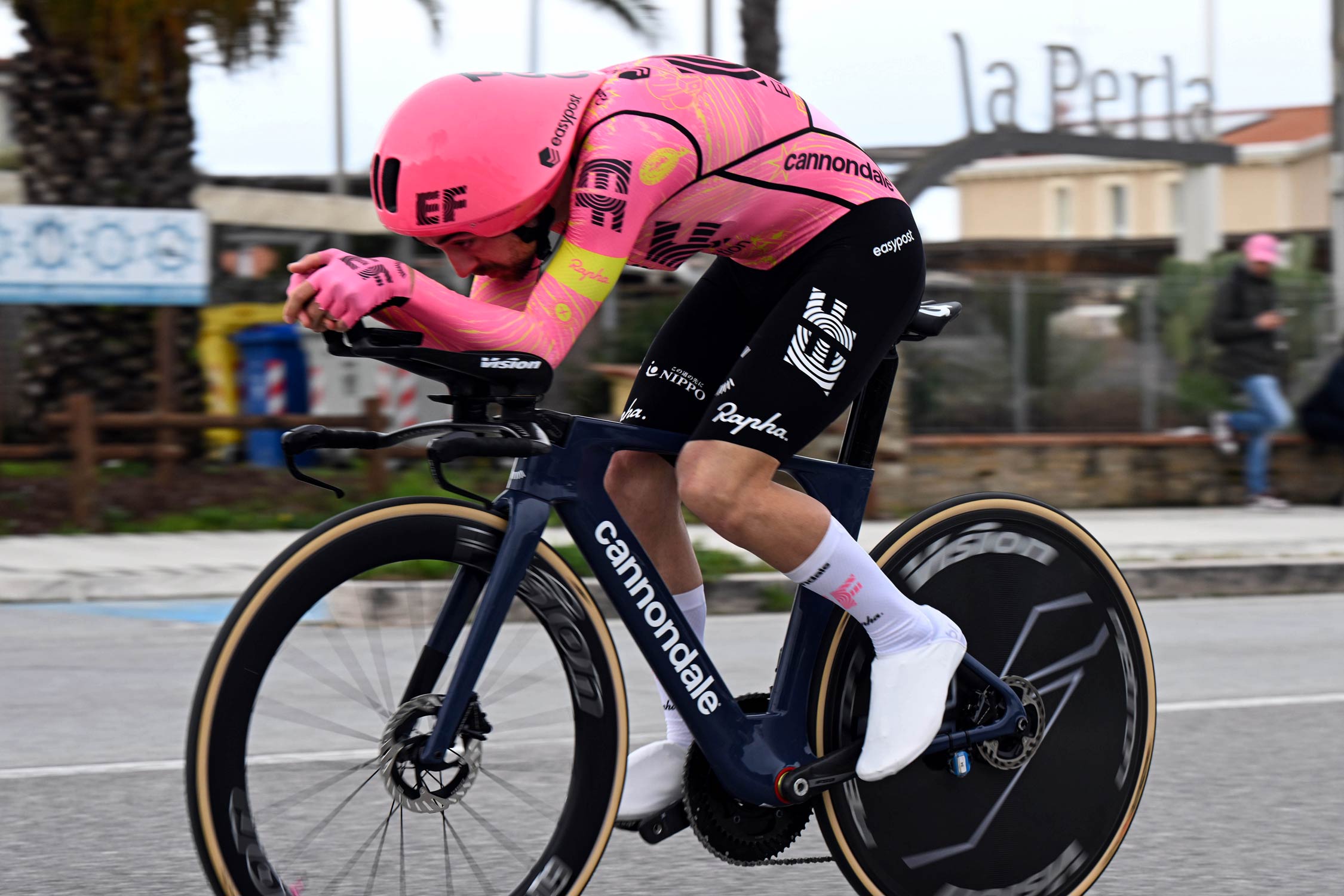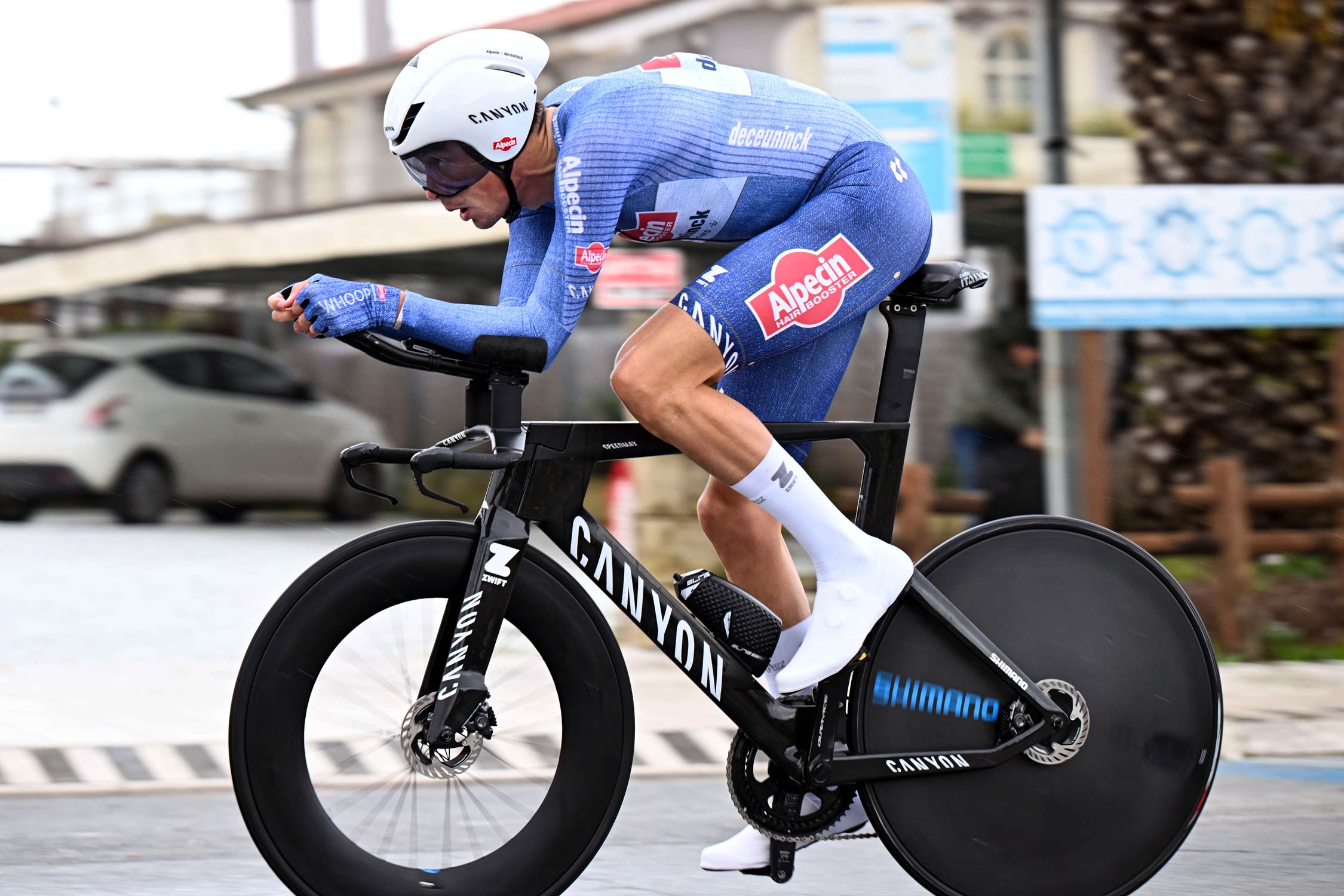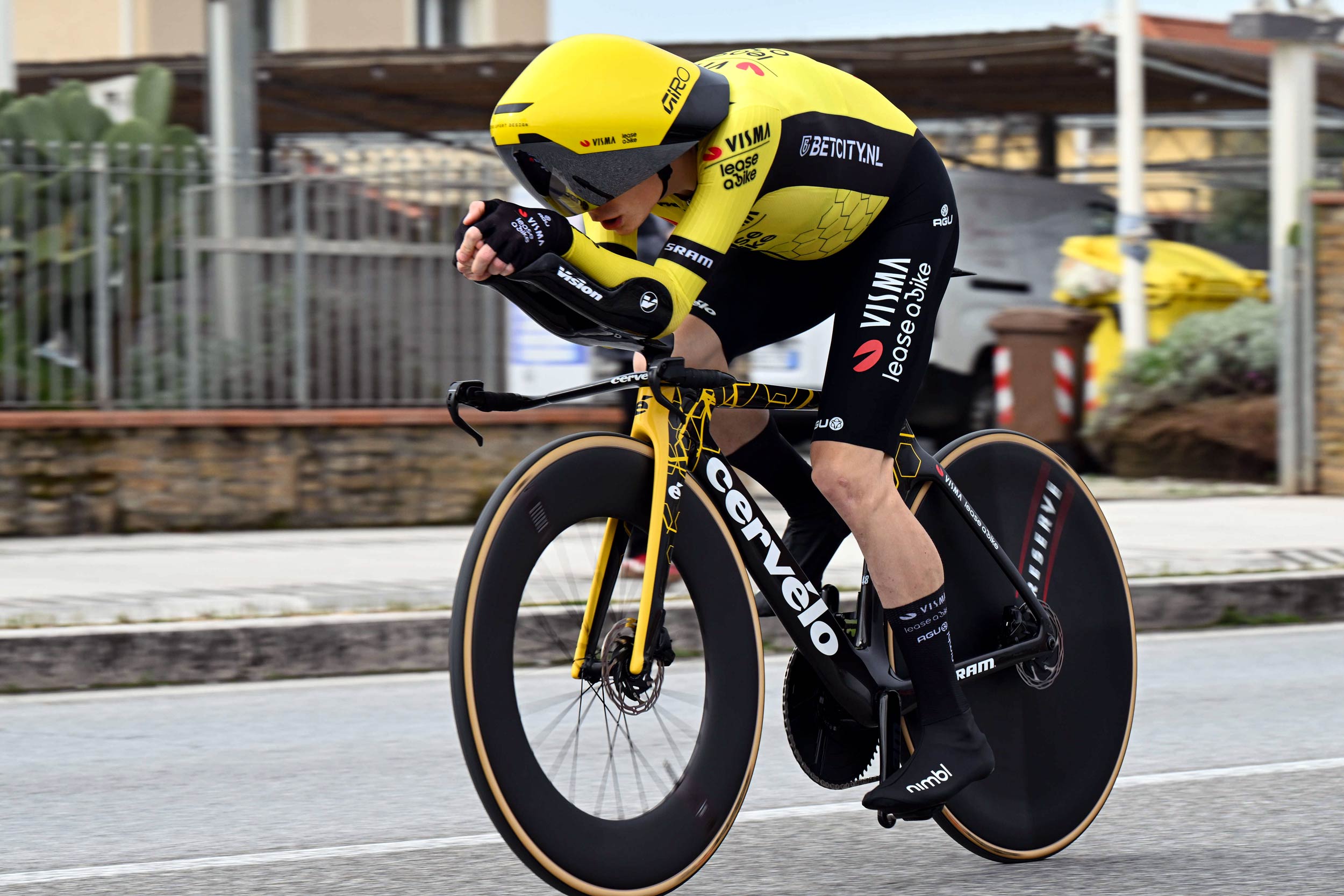The first Italian WorldTour stage race of the season is currently being contested. On day one of Tirreno-Adriatico, Juan Ayuso beat Filippo Ganna by one second in a 10km time trial when plenty of tech innovation was on display.
Photos by Stefano Sirotti
The obvious talking point of the opening stage of Tirreno-Adriatico in 2024 was helmets. Or, rather, the extreme style of the helmets worn by riders from the Visma-Lease A Bike team. Giro is the new helmet sponsor of the Dutch team and the oversize ‘Aerohead 2.0’ was difficult to ignore, even if the aerodynamic benefits of the oversize design wasn’t enough to impact the top order of the results.
The best-placed Visma-Lease A Bike rider was Jonas Vingegaard who finished ninth, 22 seconds behind stage winner Juan Ayuso of UAE Team Emirates (below).
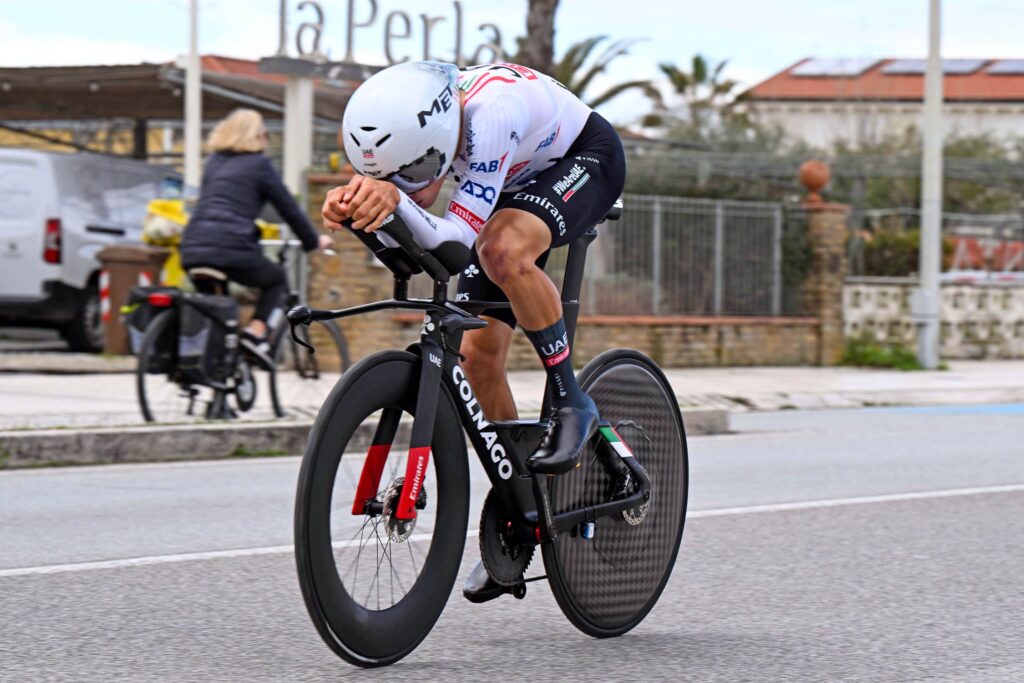
Juan Ayuso covered the 10km course at an average speed of 52.632km/h, beating Filippo Ganna by one second in stage one.
For Australian fans there were promising signs of good form from Jai Hindley one month on from his season debut in the Volta Valenciana when he finished fifth on GC. The 2022 Giro d’Italia champion finished 12th in the opening stage of Tirreno-Adriatico, only 24 seconds behind Ayuso.
The first stage was the second time trial of the 2024 WorldTour season, following the 12.1km individual TT of the UAE Tour two weeks earlier when UAE Team Emirates dominated the second stage on Al Hudayriyat Island, claiming the top three places thanks to Brandon McNulty, Jay Vine and Mikkel Bjerg.
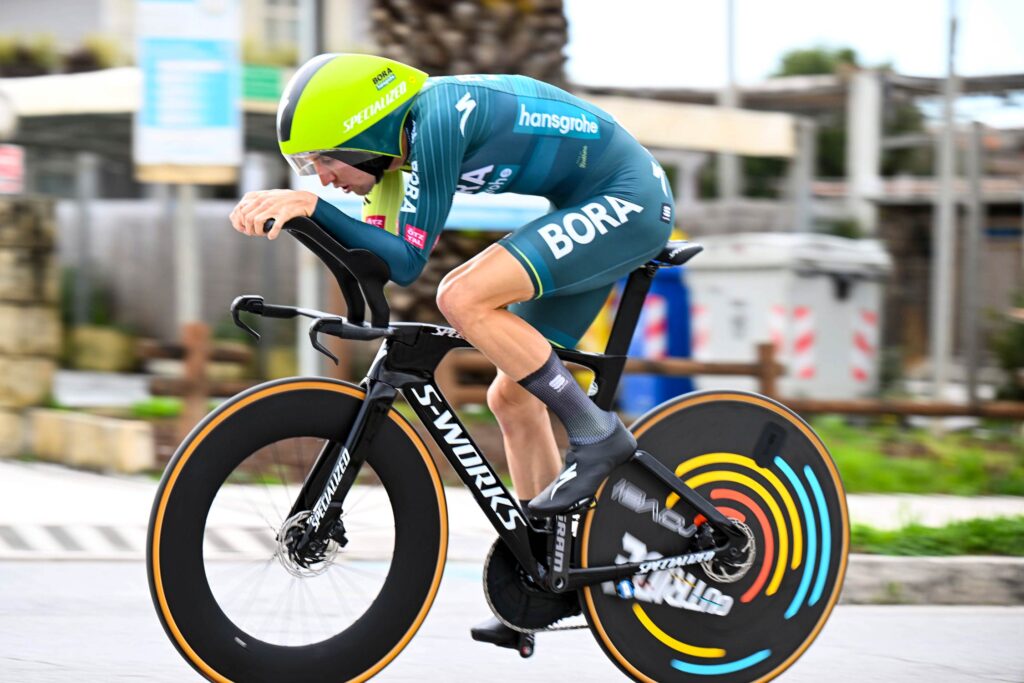
Jai Hindley finished 12th in stage one. A day later, the style of helmet he was wearing would be given notice by the UCI… it is only allowed in competition through to 2 April 2024.
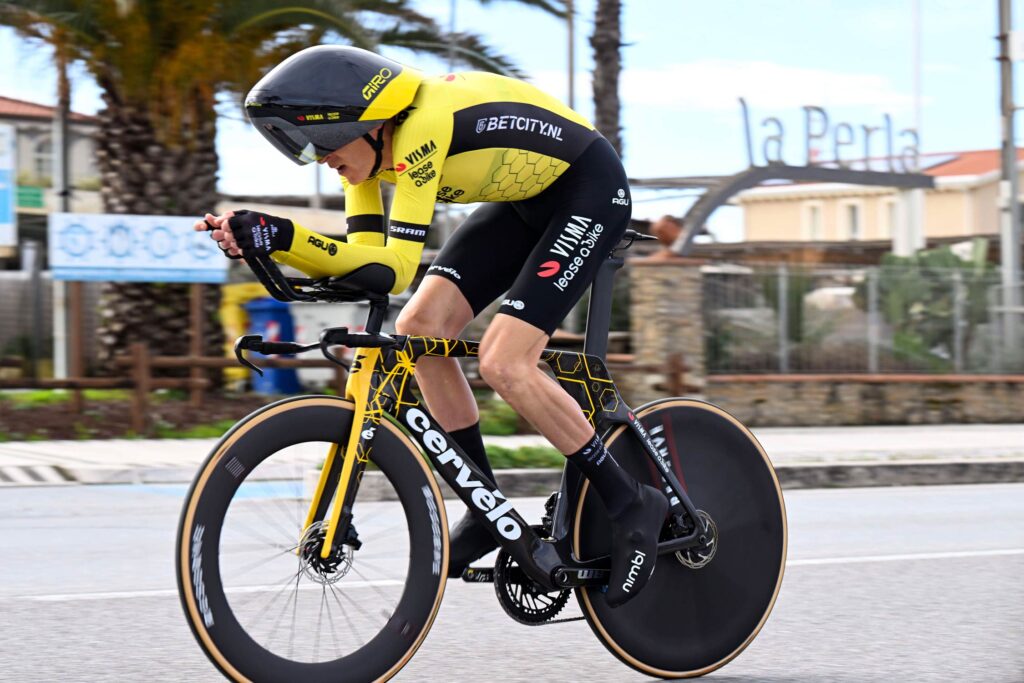
Visma-Lease A Bike riders used a variety of colours on Giro’s eye-catching ‘Aerohead 2.0’ helmet as well as significantly different riding positions. The TT stance of Robert Gesink (pictured) is considerably higher than his team-mates. He also had a largely black helmet while others were predominantly yellow, except for Attila Valter (below) who had a Hungarian champion’s themed Aerohead 2.0.
A day after we saw several teams experimenting with new equipment and extreme TT positions, the UCI announced that it would “carry out an in-depth analysis of the regulations governing the design and use of time trial helmets”. Furthermore, the sport’s governing body also explained that Specialized’s TT5 helmet, as used by Hindley and others from his Bora-Hansgrohe team (as well as other Specialized-sponsored teams) “will no longer be permitted for use at events on the UCI International Calendar, effective from 2 April, 2024”.
It is easy to see the logic of the extreme designs that are emerging in the quest for faster times, but the UCI suggests that aerodynamic advantages shouldn’t be the dominant consideration for equipment used primarily for safety purposes.
“Regarding the helmet manufactured by Giro Sport Design, which was used by Team Visma-Lease a Bike at the Tirreno-Adriatico prologue, as well as the Rudy Project Windgream HL 85 helmet (used by Bahrain Victorious) and POC Tempor helmet (used by several teams),” reads the official release. “The UCI acknowledges that while this may not directly contravene existing UCI regulations, it raises a significant issue concerning the current and wider trend in time trial helmet design.”
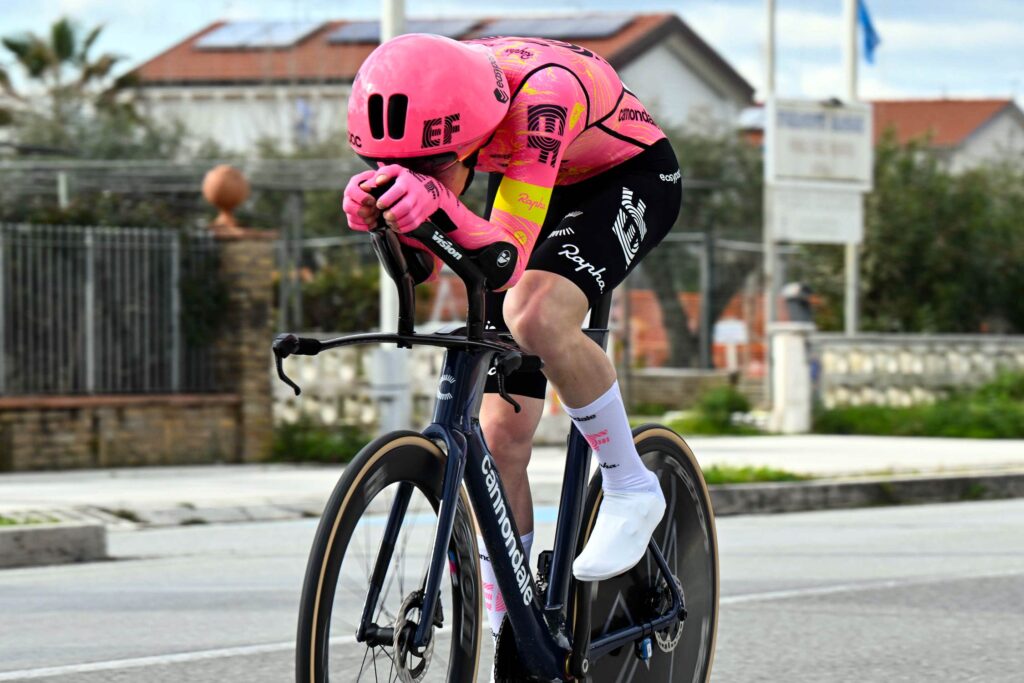
Georg Steinhauser and the POC helmet that the UCI says is part of the reason for the “in depth analysis of regulations governing the design and use of time trial helmets”.
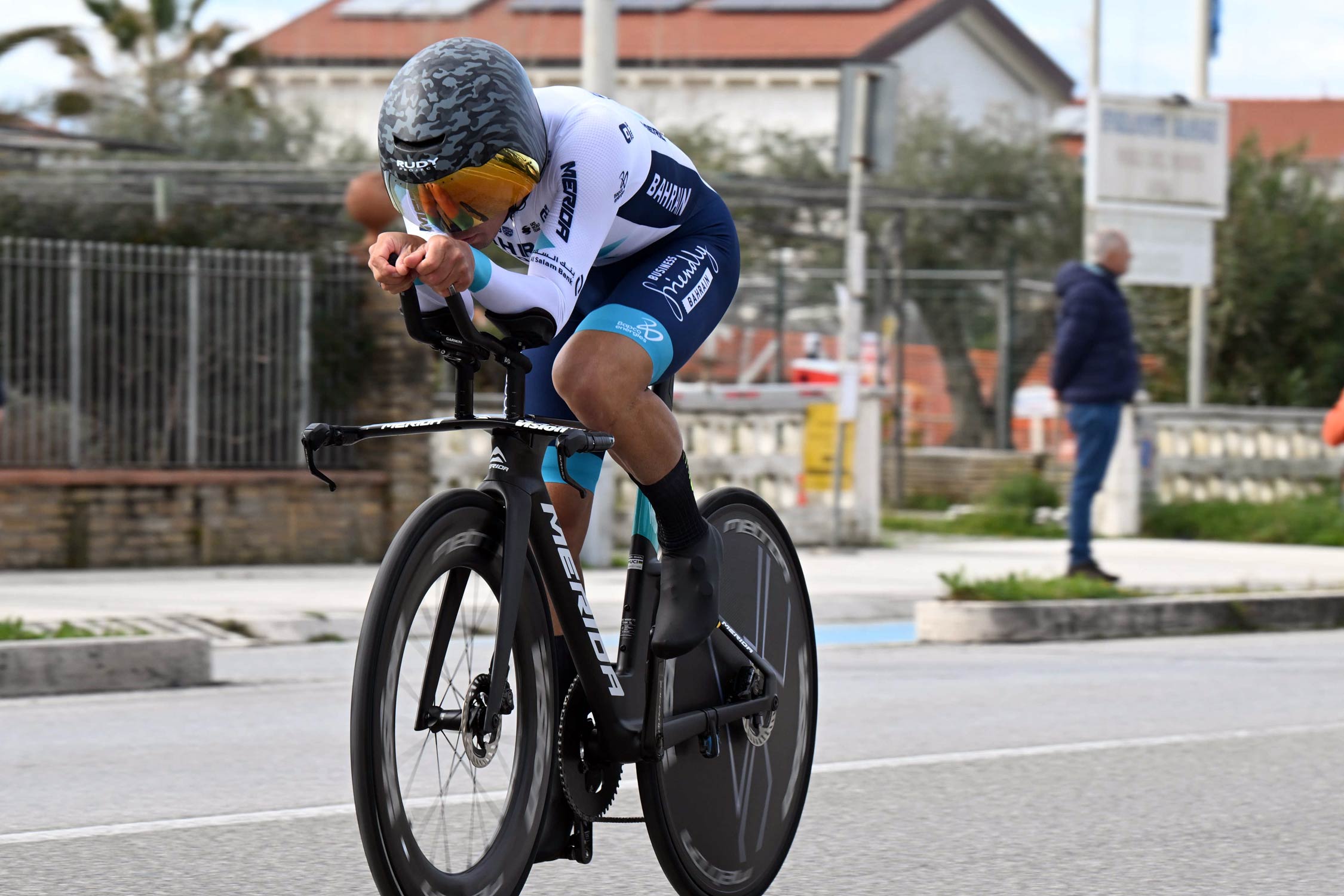
The latest TT helmet from Rudy Project is also mentioned in the UCI’s response to helmet innovation…
We wait to see what comes from the “in-depth analysis”. The release offered no timeline for how long the UCI expects this process to take but the key consideration for the review relates to ensuring the safety of riders. The concern about the “wider trend” in helmet design, according to the UCI, is that it “focuses more on performance than the primary function of a helmet, namely to ensure the safety of the wearer in the event of a fall”.
Ganna ahead of Milan
Filippo Ganna (Ineos Grenadiers) missed out on victory in the TT by just one second while his team-mate from the dominant pursuit victory at the Tokyo Olympics, Jonathan Milan (Lidl-Trek), claimed third place. It’s a hint that these two track riders who have also carved out a career on the road are in form and happy to push the pace on Italian soil.
Meanwhile, another team pursuit rider – Ethan Vernon, who was part of the gold medal winning GB team at the worlds in 2022 – scored fourth place in the TT of Tirreno-Adriatico.
Scroll down the page to see the positions of the top four in stage one.
Aerodynamics over good vision…
The lessons of Stefan Küng’s dramatic crash during the European championships last September may have changed how some riders approach the time trial, but if you look at the images from the TT of stage one it’s clear that getting aero is still the priority. Seeing where you are going seems a secondary consideration for the likes of Michal Kwiatkowski (Ineos Grenadiers), Caleb Ewan (Jayco-AlUla) and Marco Brenner (Tudor Pro Cycling), amongst others.
Ultimately the riders are the ones who must decide if having limited vision is worth the risk and although the photos suggest that it would be difficult for the trio above to see where they are riding, the images don’t tell the full story. Riders have been nestling their face in their hands more and more in recent years and the only major accident that has been reported to date is that of Küng.
The concern for the UCI is for the pro cyclists, but also young riders who like to try and emulate the best in the world. And so the regulation review will surely include provisions to ensure that safety remains the focus, not just in the pro peloton but for time trials by cyclists of all abilities.
The governing body has long been criticised for regulations that are deemed trivial by many. The UCI has also been known to actively try and limit innovation for the sake of speed, especially if the bike and/or position is so extreme that it means the aesthetic of cycling is at risk of changing. The best examples of regulations being introduced because of the success of unorthodox equipment and riding position are, of course, those of Graeme Obree.
It was, after all, after Obree burst onto the scene in 1993 – winning the individual pursuit world championship and then breaking the hour record – that numerous changes were made to the regulations relating to equipment and rider positions. When his initial original design was deemed “illegal” by the UCI, Obree continued to innovate… and the so-called ‘Superman’ position was pioneered with great success.
Each time Obree dreamed up a way to beat the wind, the UCI managed to put a halt to it.
We wait to see if the shapes of some helmets (and other items) will continue to go to extremes, or if the UCI will again put a halt to innovation for the sake of the safety of riders – and, of course, the quest for the ‘right’ cycling aesthetic… whatever that actually is.
In the meantime, we can marvel at the efforts of manufacturers and riders alike as they seek to eke out as much speed with as little resistance as possible. Scroll further down the page for more from the TT gallery of stage one.
– By Rob Arnold
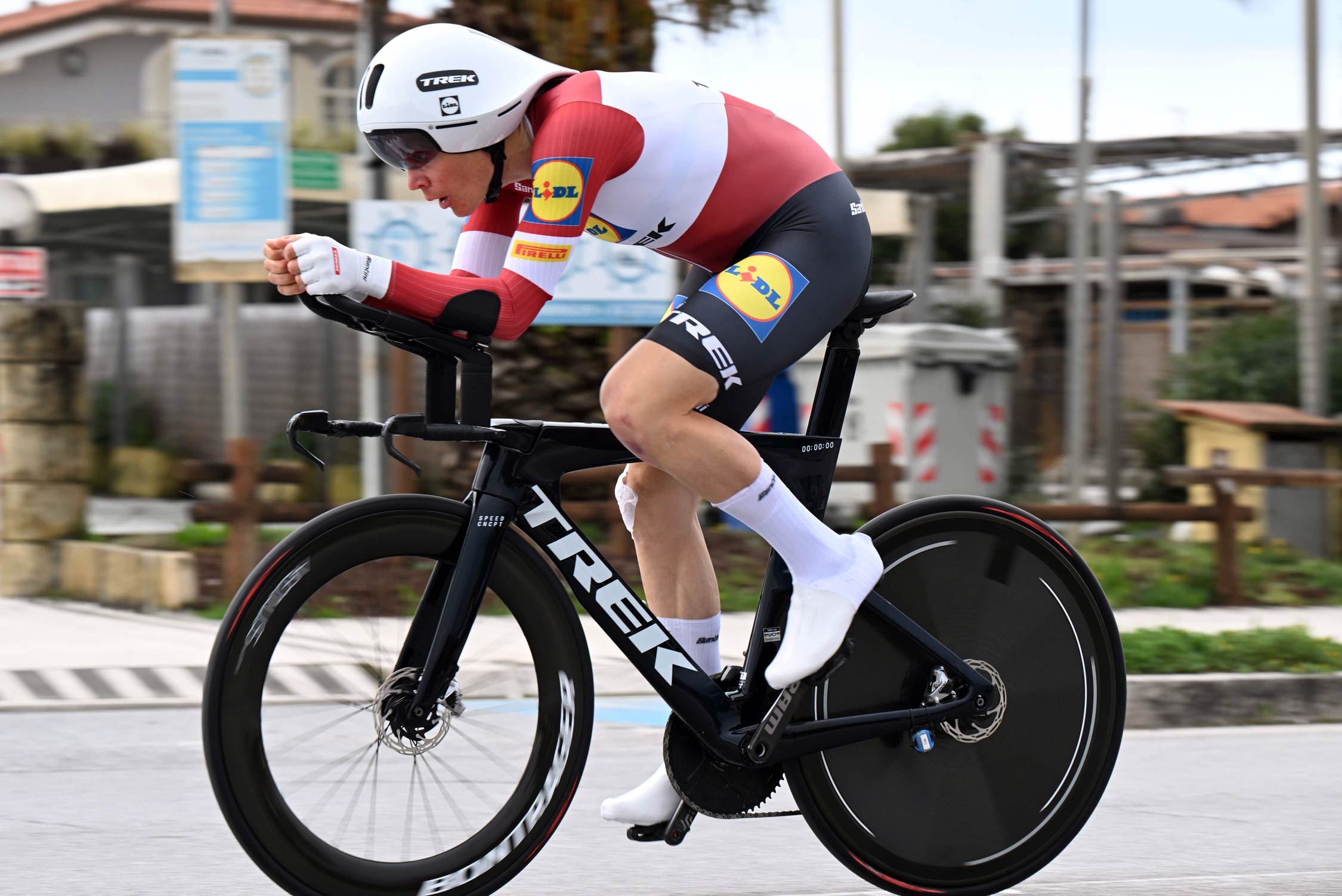
Trek rider Toms Skujins opted for a POC helmet rather than the team-issue Trek TT option (which also appears to be part of a redesign push).
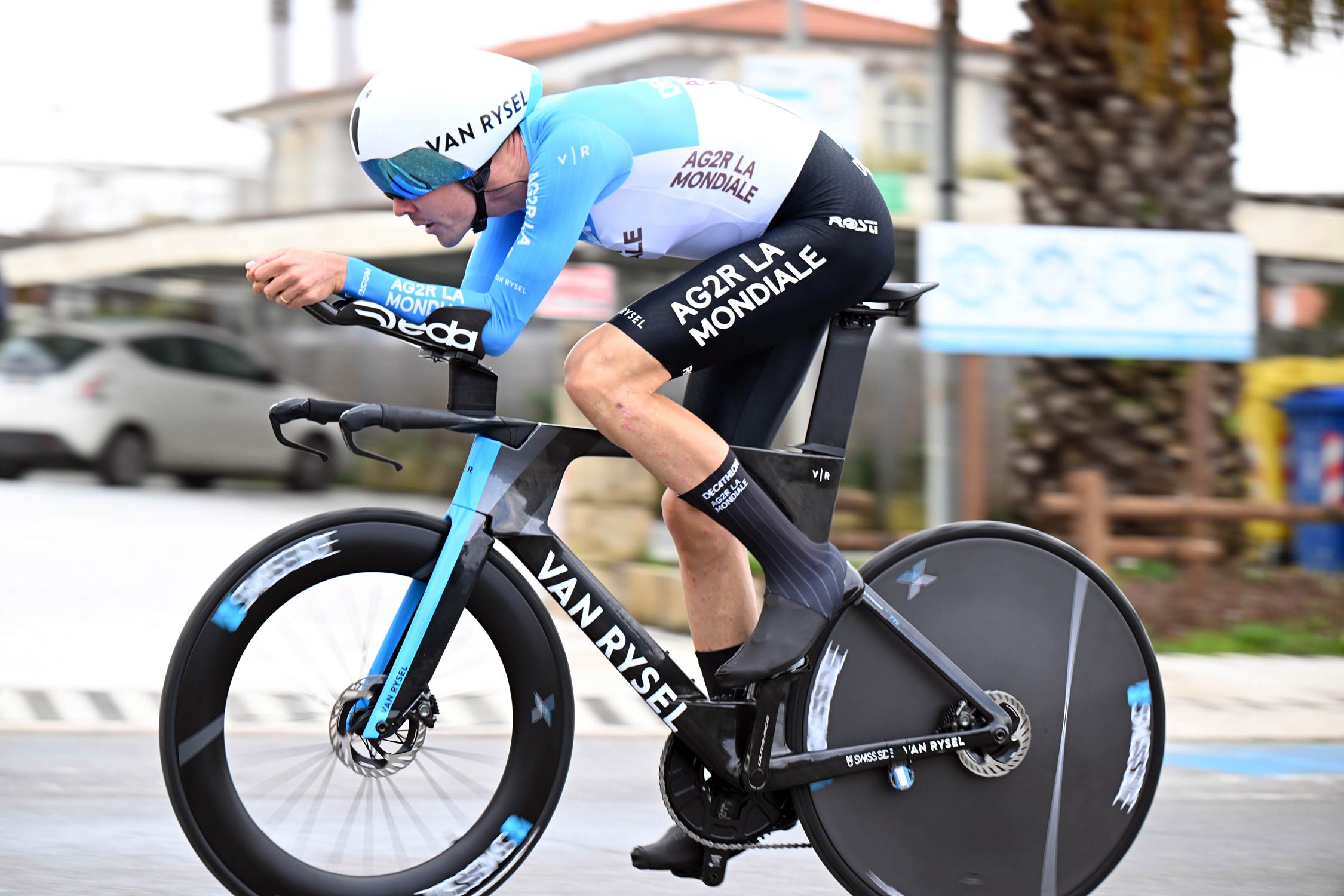
Ben O’Connor has already won a couple of times in 2024. He was 30 seconds off the winning time in the TT.
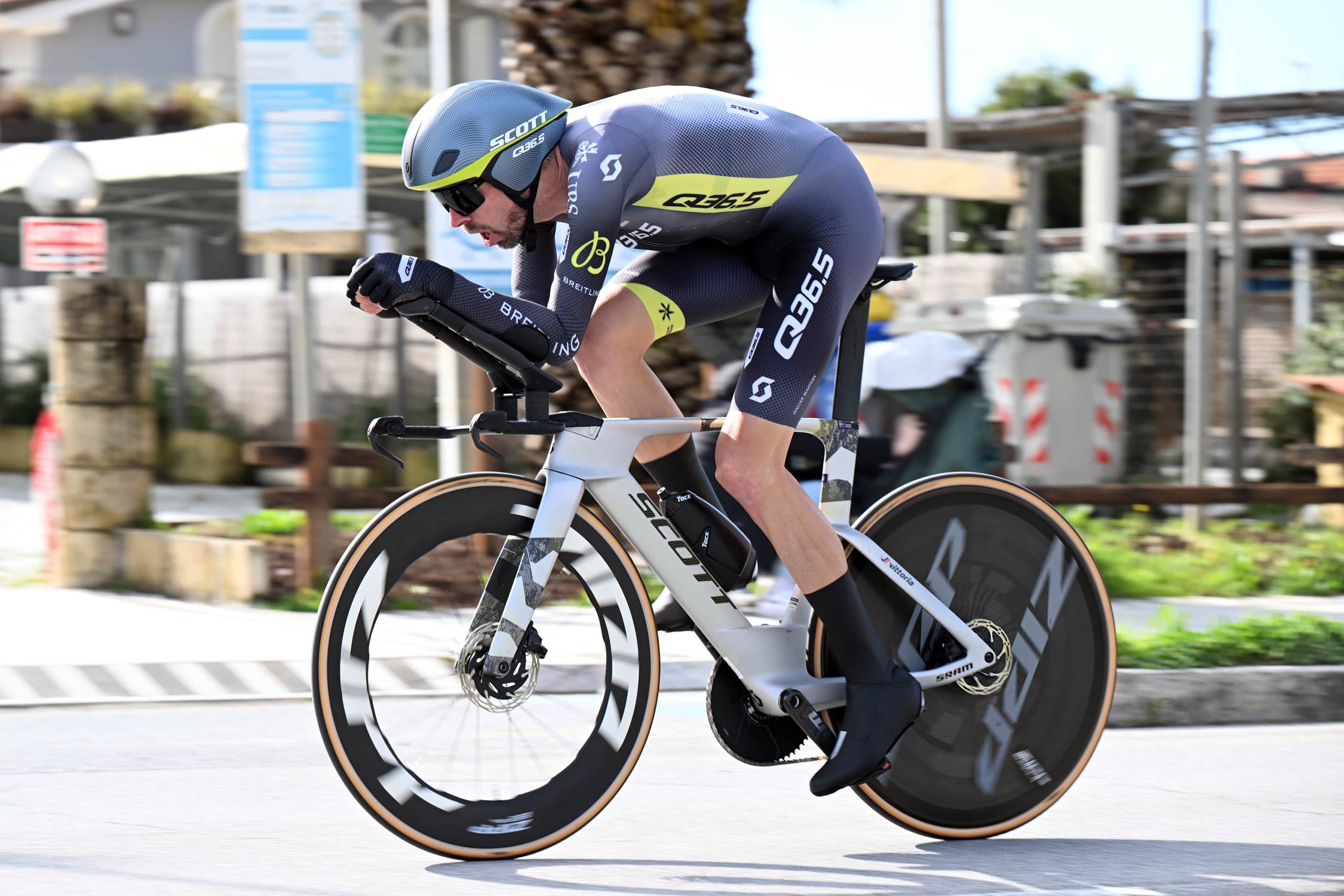
Damien Howson gets low for a tall rider… the under-23 world champion from 2013 was 59th in the Tirreno-Adriatico TT.


